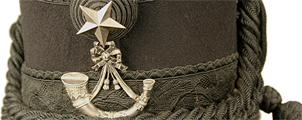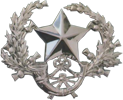Tanks in the Orchard
As the positions around Eterville was stabilized during the early hours of 11 July, German mortar and artillery attacks continued. Major Davies of the 2nd Glasgow Highlanders arrived to take over command of the 9th. He took over a desperately confused situation. Signallers arrived back at Battalion HQ and reported that D Company’s HQ was deserted. They could only find the Company Commander, Captain Baldwin, lying down in a slit trench moaning.
Major Davies set about sending patrols to verify the position of the areas where the German infiltration had occurred. Men of the Carrier Platoon discovered the gaps in the area of D Coy and started to rectify the holes in the line. Expecting the Germans to again counter-attack, Major Davies asked the Brigade Commander, Brigadier Barber, for a company of the Glasgow Highlanders, who arrived at 0500. At 0600 a German patrol approached the positions of C Coy in an orchard. Five of the enemy were shot and the officer in charge was taken as a prisoner.
at 0830 the men of C Company spotted German tanks approaching their position. The Germans moved at an angle towards B Company. Artillery was called for, yet the Panzers continued to edge closer. As soon as they entered firing range the Cameronians of B Coy opened fire with a P.I.A.T. The tank slowed down and turned about, flames beginning to burst out of the hatches. It was unclear whether or not the P.I.A.T or an artillery round had ignited the vehicle, but for the Scots in slit trenches, the only important thing was that it was no longer a threat to them. Yet, in one of the more brutal realities of the war the threat of the crewmen remounting and continuing to fight needed to be stopped. As the German tankers poured out, two were shot down by Rifleman Long.

© IWM (B 6185)
A second tank approached the Cameronians and started to fire its machine guns into C Company from 70 yards away. P.I.A.T’s were fired but missed the tank. However the presence of Anti-Tank weapons convinced this tank to withdraw. At this time German infantry infiltrated into an edge of the orchard held by C Company. Rfn. Long again became engaged, shooting at least two of the enemy before he himself was wounded. Corporal Lormier took his section forward, with swords fixed. They drove the remaining German infantry out of the Orchard, killing at least five.
Seeing their attack stymied the Germans laid down a smokescreen and began to attempt moving around C Company. A third tank approached almost on top of the Cameronians’ position before the tank commander was shot while peering out of his cupola by Rfn. Brandon. The remaining Panzers began to withdraw covered by their infantry

© IWM (B 6049)
At 0900 Lt. Col. Villiers returned to retake command, and Brig. Barber decided it was time to rotate the 9th out for the Glasgow Highlanders. Yet before this relief could take place reports started coming in again from B and C Companies reporting another German attack massing to their front. at 1030 the Germans advanced, coming within 100 yards of the Cameronians before C Company opened fire with every weapon at it’s disposal. Lt. Quinn, then in Command of C Coy reported at least 4 sections of the enemy lying dead in front of their position, a minimum of 120 killed or wounded within the orchard itself.

© South Lanarkshire Council
at 1430 the 2nd Glasgow Highlanders arrived and relieved the 9th Cameronians. Within their position they reported five German tanks having been knocked out (three Tigers and two Panthers or Panzer IV’s belonging to the 1st SS Panzer Division). Throughout the entire relief, the 9th was subjected to intense shelling, finally going into reserve at Rocrenil where the shelling continued and casualties continued to mount. For the entire action around Eterville the 9th Cameronians (Scottish Rifles) reported:
Killed Capt Evans; wounded MAJOR S. BINGLEY, Major R. DOWNIE; Capt Baldwin, Capt COOK RACHD, Lt Kirby; Lt Muir; Lieut Barnes. Other ranks 12 killed; 101 wounded; 26 missing.
One of those killed was 21-year old Rifleman John McLuckie of Bellshill, Lanarkshire. His parents John and Helen had inscribed on his headstone a phrase which all of us as historians should make as the mainstay for our work and research.
YEARS SHALL NOT DARKEN NOR SHADOWS DIM THE LASTING MEMORIES WE HAVE OF HIM
https://www.cwgc.org/find-war-dead/casualty/2323361/mcluckie,-john/
Comments: 0



Leave a Reply